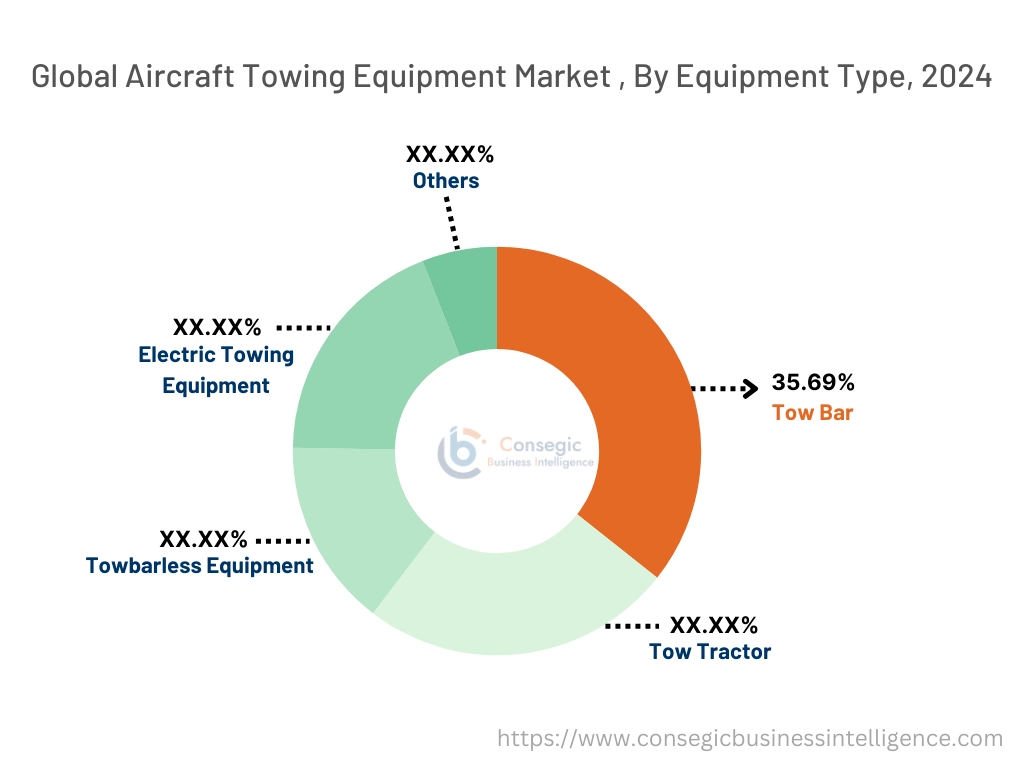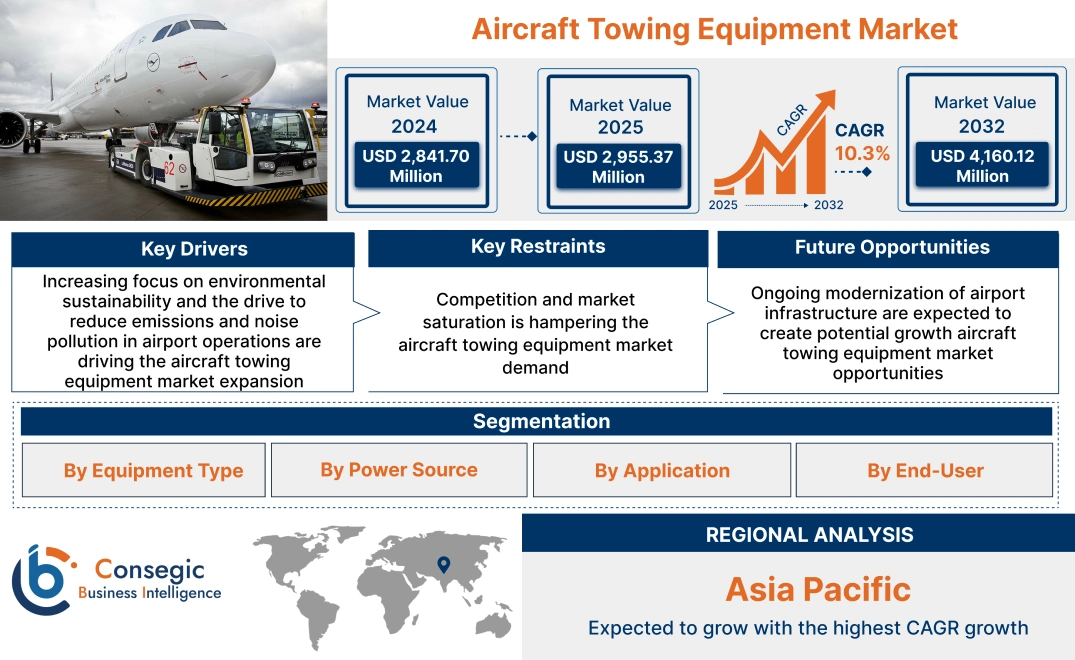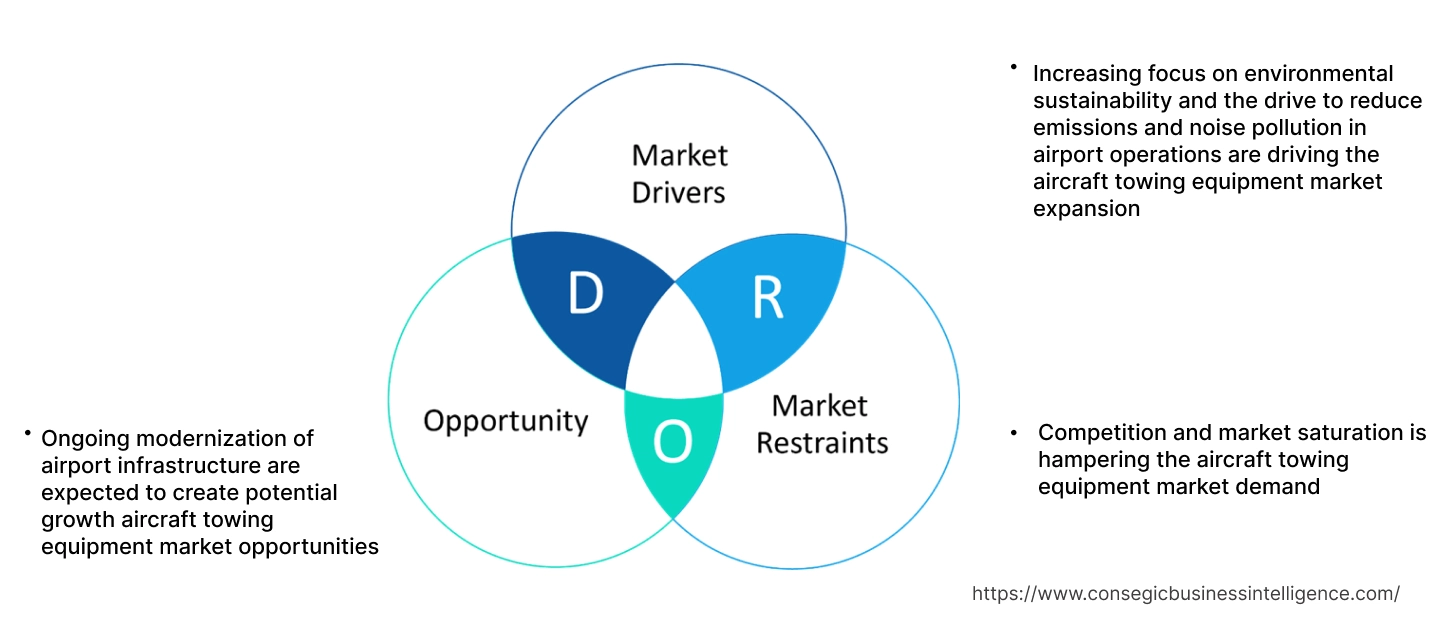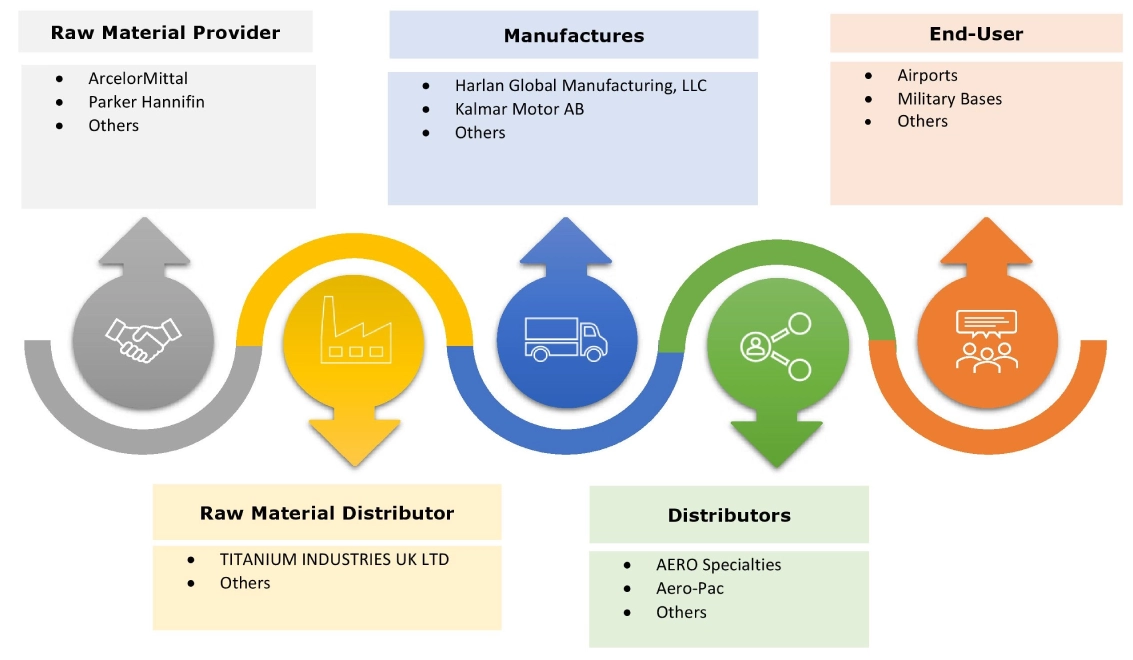- Summary
- Table Of Content
- Methodology
Aircraft Towing Equipment Market Size:
Aircraft Towing Equipment Market Size is estimated to reach over USD 4,160.12 Million by 2032 from a value of USD 2,841.70 Million in 2024 and is projected to grow by USD 2,955.37 Million in 2025, growing at a CAGR of 4.4% from 2025 to 2032.
Aircraft Towing Equipment Market Scope & Overview:
Aircraft towing equipment is essential for ensuring efficient and safe ground operations. This encompasses pushing aircraft away from the gate, towing them between the hangar and the gate, and relocating them for maintenance purposes. The most prevalent types of towing equipment are aircraft towbars and aircraft tugs. The variety of towing equipment available in the market addresses the diverse requirements of airlines, airports, and maintenance providers, contributing to the overall growth and dynamism of the aircraft towing equipment market.
Key Drivers:
Increasing focus on environmental sustainability and the drive to reduce emissions and noise pollution in airport operations are driving the aircraft towing equipment market expansion
As concerns about the environmental impact of aviation activities escalate, the demand for eco-friendly solutions to mitigate the industry's carbon footprint is increasing. Electric and hybrid propulsion systems for towing equipment provide cleaner and quieter alternatives to traditional diesel-powered vehicles, which align with sustainability objectives and regulatory initiatives aimed at reducing emissions and noise levels in airport settings. Manufacturers that invest in the development of electric or hybrid towing equipment can leverage this trend by offering environmentally responsible solutions that meet the evolving needs of airports and airlines committed to greener practices. The implementation of these systems not only addresses environmental issues but also delivers operational advantages, such as reduced maintenance costs and improved efficiency. Electric towing vehicles have lower operating costs compared to diesel-powered models, requiring less maintenance and featuring fewer moving parts, which results in decreased downtime and a lower total cost of ownership throughout the vehicle's lifespan. Moreover, electric and hybrid towing equipment offers quieter operation, enhancing working conditions for ground handling personnel and minimizing noise pollution in airport environments. By emphasizing these operational benefits along with their environmental merits, manufacturers can effectively position electric and hybrid towing equipment as compelling options for airports and airlines aiming to modernize their ground support fleets.
- For instance, in January 2021, Munich Airport deployed all-electric aircraft tow tractor, to protect climate goals which will be completely carbon neutral by 2030. To accomplish this ambitious objective, Munich Airport is introducing numerous technological innovations across all sectors and has significantly increased both the percentage of electric vehicles in its fleet and the corresponding charging infrastructure.
Thus, according to the aircraft towing equipment market analysis, the developments in electric and hybrid propulsion systems are driving the aircraft towing equipment market size.
Key Restraints:
Competition and market saturation is hampering the aircraft towing equipment market demand
In the competitive aircraft towing equipment market, the presence of numerous manufacturers and suppliers competing for market gain, creating saturation and heightened rivalry. With a wide array of options available to customers, manufacturers struggle to differentiate their products and solutions from those of competitors. This intense competition can lead to downward pressure on prices, as companies compete for contracts and customers seek the most cost-effective options. Consequently, profit margins may become tighter, particularly for manufacturers that lack differentiation or innovative capabilities to justify premium pricing for their products.
Market saturation and fierce competition also drive manufacturers to consistently innovate and distinguish their offerings to maintain a competitive advantage. Companies that successfully differentiate their products through features such as advanced technology, improved performance, durability, or superior customer service are better equipped to withstand pricing pressures and achieve premium pricing in the market. These factors and analysis are hindering the progress of the market trends.
Future Opportunities :
Ongoing modernization of airport infrastructure are expected to create potential growth aircraft towing equipment market opportunities
The market presents numerous opportunities for development, driven by the rapid expansion of the aviation sector and the ongoing progression of airports infrastructure. As airports worldwide work towards sustainability objectives and aim to minimize their carbon footprints, the need for environmentally friendly ground support equipment is increasing. This transition to electric and hybrid aircraft tugs presents substantial growth prospects for manufacturers and suppliers in the industry. Additionally, improvements in battery technology and the establishment of efficient charging infrastructure are expected to facilitate the adoption of electric tractors, paving the way for further market development.
- For instance, in February 2024, the FAAM Laboratory, launched an electric-powered aircraft tug, to reduce carbon emissions from the research facility’s operations. The FAAM Airborne Laboratory's research aircraft, a specially modified BAE-146 equipped with scientific instruments, necessitates a vehicle for towing and transporting heavy items around Cranfield Airport, including its ground power unit.
Thus, based on the above analysis, these factors are driving the aircraft towing equipment market opportunities.
Aircraft Towing Equipment Market Segmental Analysis :
By Equipment Type:
Based on the equipment type, the market is segmented into Tow Bar, Tow Tractor, Towbarless Equipment, Electric Towing Equipment, and Others.
Trends in the equipment type:
- The growing global need for air travel is a significant catalyst for change. An increase in flights leads to a heightened need for efficient ground handling, including aircraft towing.
- Airlines are consistently expanding their fleets to satisfy passenger demand, necessitating the procurement of additional towing equipment to manage the larger volume of aircraft.
- Modern towing equipment features safety enhancements such as automatic braking systems, better visibility, and improved manoeuvrability, all of which contribute to safer ground operations.
The towbar segment accounted for the largest revenue share of 35.69% in the year 2024.
- The rising growth in international tourism and domestic air travel has prompted low-cost carriers to expand their fleets to accommodate the requirement for aircraft towbars.
- Low-cost carriers' fees are more affordable than those of full-service airlines, appealing to a growing number of consumers, especially budget-conscious travellers. Consequently, with more low-cost carriers, including Southwest Airlines, AirAsia, Indigo, and SpiceJet, planning to enlarge their aircraft fleets, the segment is projected to experience substantial growth throughout the forecast period.
- These factors would further drive the aircraft towing equipment market during the forecast period.
The tow tractor segment is anticipated to register the fastest CAGR during the forecast period.
- The growing need for technologically advanced aircraft ground support equipment has prompted airports and airlines to invest in sophisticated tractors.
- With the rise in air travel and an increase in the number of airports worldwide, there is a need for more towed solutions. Furthermore, developing countries are enhancing their ground support facilities, enabling manufacturers to promote more advanced towing tractors.
- For instance, Oshkosh AeroTech is broadening its range of conventional tow tractors. The company started manufacturing the B-series of diesel-powered tractors and is adding all-electric versions to that product line. Oshkosh AeroTech's tractors would be designed to service a wide range of aircraft, from the B737 to the A380, making them ideal for high-traffic ramps.
- Thus, based on the analysis these factors and developments are driving the aircraft towing equipment market size and trends during the forecast period.

By Power Source:
Based on the power source, the market is segmented into Internal Combustion Engine, Electric, and Hybrid.
Trends in power source:
- In recent years, electric towing vehicles have gained considerable popularity. They provide several benefits, such as zero emissions, diminished noise pollution, and reduced operating expenses. Progress in battery technology is further propelling the adoption of electric tugs.
- Hybrid tugs merge the advantages of both internal combustion engines (ICE) and electric powertrains. They can run on electricity for shorter distances and transition to the ICE engine for longer trips or when greater power is necessary.
The electric segment accounted for the largest revenue share in the year 2024 and is expected to register the highest CAGR during the forecast period.
- Electric systems employ battery-powered motors, ensuring clean and quiet operation ideal for environmentally sensitive locations such as airports and their adjacent communities.
- Advancements in battery technology and electric motor design have made fully electric aircraft tugs more viable and cost-effective. Further, enhancements in energy density, charging times, and overall performance have increased the feasibility and attractiveness of these solutions, making them more attractive option for airports and ground handling service providers.
- Electric tow tractors, for example, generate zero emissions and operate more quietly than their non-electric counterparts. The integration of electric technology supports the industry's overarching trend toward sustainability and minimizing carbon footprints, which is especially crucial in the aviation sector recognized for its environmental impact.
- In October 2024, Biju Patnaik International Airport, deployed electric vehicles to tow aircraft between aprons and runway holding points. Currently, the aircrafts operating at the airport are reaching the aprons from holding points under their own power. After the new system is implemented at the airport, they will be towed to the aprons by electric vehicles. They will not only reduce emissions but also conserve fuel for the airlines.
- Therefore, based on the above aircraft towing equipment market analysis, the electric segment will be dominating the market during the forecast period.
By Application:
Based on the application, the market is segmented into Commercial Aviation, Military Aviation, and Private Aviation.
Trends in the Application:
- Stringent environmental regulations and policies are driving airports and airlines to adopt more sustainable ground handling equipment.
- Airlines continually aim to reduce aircraft turnaround times to enhance utilization and profitability. Effective towing equipment is essential for this purpose.
- The incorporation of technologies such as GPS, telematics, and remote-control systems is improving operational efficiency by refining tracking, optimizing routes, and reducing the need for human intervention.
Commercial aviation segment accounted for the largest revenue share in the year 2024.
- Commercial airlines and airports use aircraft towing equipment for standard ground handling activities related to passenger and cargo operations. This involves towing aircraft to and from gates, hangars, and maintenance facilities, in addition to positioning them for refuelling and servicing.
- As the global aviation sector evolves and expands, there is a rising need for efficient and dependable ground handling equipment, such as towbar tractors and towbarless tractors. Airports and airlines are looking for towing solutions that improve operational efficiency, shorten turnaround times, and lessen disruptions to flight schedules, thereby fostering the adoption of advanced towing technologies and services.
- In June 2023, Lokpriyo Gopinath Bordoloi International Airport, launched its first electric towing equipment to handle operations on the ground. Indigo is the first airline to implement the service at the airport, adhering to the mandate set by the officials at Guwahati airport to replace all feasible conventional fuel-based vehicles with electric alternatives as swiftly as possible.
- These factors would further supplement the aircraft towing equipment market trends during the forecast period.
The military aviation segment is anticipated to register the fastest CAGR during the forecast period.
- In the military sector, the need for aircraft towing equipment is fuelled by defense budgets, military modernization initiatives, and operational needs.
- Military entities require durable and adaptable towing solutions that can accommodate diverse aircraft types, such as fighter jets, transport planes, and helicopters, across various operational settings. The enhancement of expeditionary capabilities and the necessity for swift deployment and repositioning of military assets highlight the critical role of dependable and nimble towing equipment in military operations.
- These factors would further supplement the aircraft towing equipment market trends during the forecast period.
By End User:
Based on end user, the aircraft towing equipment market is segmented into Airports and Military Bases.
Trends in the end user:
- The continually rising global air traffic is a significant factor driving the need for aircraft towing equipment. As passenger and cargo volumes increase, airports require more efficient ground handling operations, leading to a need for a larger fleet of towing vehicles.
- The aging aircraft fleet globally is resulting in heightened maintenance needs. Consequently, this is increasing the need for towing equipment to transport aircraft between hangars and maintenance facilities.
- These trends would further drive the market during the forecast period.
airports segment accounted for the largest revenue share in the year 2024
- Governments and private organizations are aggressively investing in constructing new airports and upgrading existing facilities to accommodate air traffic. These projects create a robust requirement for several types of towing equipment, such as electric and hybrid solutions.
- The use of data analytics is becoming increasingly important in airport operations. Data collected from towing equipment can be used to optimize routes, enhance maintenance schedules, and improves overall efficiency.
- These factors and analysis would further supplement the Aircraft Towing equipment market during the forecast period.
military bases segment is anticipated to register the fastest CAGR during the forecast period.
- High levels of security are essential at military bases. Towing equipment may include features like restricted access controls and advanced security systems.
- In many instances, military personnel are trained and designated to operate aircraft towing equipment. These individuals participate in extensive training to guarantee the safe and efficient operation of these vehicles.
- Several military bases may engage civilian ground handling companies to supply aircraft towing services. In these situations, civilian personnel who are trained and certified to operate the equipment are utilized.
- These factors and analysis would further supplement the aircraft towing equipment market share during the forecast period.
Regional Analysis:
The global market has been classified by region into North America, Europe, Asia-Pacific, MEA, and Latin America.

Asia Pacific aircraft towing equipment market expansion is estimated to reach over USD 975.96 million by 2032 from a value of USD 616.04 million in 2024 and is projected to grow by USD 645.07 million in 2025. Out of this, China aircraft towing equipment market accounted for the maximum revenue share of 33.56%. The development of new airports, progression of existing facilities to enhance passenger and cargo handling capacities, and the privatization of airports are anticipated to propel Asia Pacific aircraft towing equipment industry growth during the forecast period. In addition to this, current efforts by airports to reduce their carbon footprint have hastened the adoption of electric tugs, while the implementation of advanced technologies such as remotely operated pushback tugs facilitates safe and efficient airport management. These environmentally friendly initiatives by airport operators are expected to further drive the regional aircraft towing equipment market share in the coming years.
- For instance, in April 2022, The Ministry of Land, Infrastructure, and Transport of South Korea has announced plans to invest KRW 13.7 trillion (USD 10.97 billion) in the construction of a new airport on Gadeok Island. This airport is anticipated to be an offshore facility (constructed on a floating structure at sea) and will address the increasing air traffic need in the country's southeastern region.

North America aircraft towing equipment market growth is estimated to reach over USD 1,476.43 million by 2032 from a value of USD 1,013.77 million in 2024 and is projected to grow by USD 1,053.87 million in 2025. North America holds a substantial market command, backed by its strong aviation sector and continuous investments in airport upgrades. The presence of major airlines and a high volume of air traffic contribute to a significant demand for advanced towing equipment in the region. Additionally, the regional market plays a crucial role in the overall automotive and transportation sectors, fueled by the need for safe, efficient, and versatile towing solutions for heavy loads, trailers, and vehicles. It caters to a diverse clientele, ranging from regional distributors to commercial operators, all in pursuit of dependable equipment to support transportation and logistics.
- For instance, in October 2023, Hopkins Manufacturing Corporation announced the acquisition of Hayes Towing Electronics, to enhance company’s position in controls and trailer brake, while complementing its market-leading towing electrical business. With this merger & acquisition, Hayes offers a variety of vehicle-specific harnesses that facilitate easy, plug-in installation of their brake controls.
As per the market analysis, the aircraft towing equipment market in Europe is currently experiencing robust progression. A sustained rise in air passenger and cargo traffic throughout Europe requires effective ground handling operations. Aircraft tugs are essential for transporting aircraft between gates, hangars, and maintenance areas, thereby optimizing airport operations. Additionally, the expansion of low-cost carriers in Europe has heightened the necessity for economical and efficient ground handling equipment. Aircraft tugs represent a comparatively low-cost investment relative to other ground support equipment, making them an appealing choice for cost-conscious airlines. Additionally, the Latin American region is experiencing a rise in air travel demand, driven by expanding economies, heightened tourism, and a growing middle class. This calls for efficient ground handling operations, including aircraft towing, to support the higher volume of flights and passengers. Furthermore, the MEA region is witnessing a considerable increase in air travel, fueled by factors such as rising tourism, expanding business travel, and higher disposable incomes. This trend requires the management of more aircraft, leading to an increased need for tugs. Additionally, numerous airports in the region are undergoing development and modernization projects to handle the escalating air traffic. This includes investments in new terminals, runways, and ground handling equipment, resulting in a robust demand for aircraft tugs.
Top Key Players and Market Share Insights:
The global aircraft towing equipment market is highly competitive with major players providing solutions to the national and international markets. Key players are adopting several strategies in research and development (R&D), product innovation, and end-user launches to hold a strong position in the market. Key players in the Aircraft Towing equipment industry includes-
- Aero Specialties (U.S.)
- Vestergaard Company (Denmark)
- Goldhofer (Germany)
- Oshkosh (U.S.)
- Textron (U.S.)
- MULAG Fahrzeugwerk (Germany)
- TLD Group (France)
- Harlan Global Manufacturing, LLC (U.S.)
- Kalmar Motor AB (Sweden)
- Eagle Tugs (U.S.)
- Toyota Industries (Japan)
Recent Industry Developments :
Partnership:
- In March 2022, All Nippon Airways announced the partnership with Toyota Industries, to conduct a test of autonomous tow tractor in the restricted area at Tokyo Haneda Airport. Toyota Industries will launch a newly developed autonomous tow tractor featuring enhanced location tracking capabilities, facilitating seamless operations in both indoor and outdoor settings. This advanced, high-precision model can transport substantial cargo, even in the congested driving conditions at Tokyo Haneda Airport. The new tractor offers improved location tracking and towing capacity, including on inclined surfaces.
Aircraft Towing Equipment Market Report Insights :
| Report Attributes | Report Details |
| Study Timeline | 2019-2032 |
| Market Size in 2032 | USD 4,160.12 Million |
| CAGR (2025-2032) | 4.4% |
| By Equipment Type |
|
| By Power Source |
|
| By Application |
|
| By End User |
|
| By Region |
|
| Key Players |
|
| North America | U.S. Canada Mexico |
| Europe | U.K. Germany France Spain Italy Russia Benelux Rest of Europe |
| APAC | China South Korea Japan India Australia ASEAN Rest of Asia-Pacific |
| Middle East and Africa | GCC Turkey South Africa Rest of MEA |
| LATAM | Brazil Argentina Chile Rest of LATAM |
| Report Coverage |
|
Key Questions Answered in the Report
How big is the Aircraft Towing Equipment market? +
Aircraft Towing Equipment Market Size is estimated to reach over USD 4,160.12 Million by 2032 from a value of USD 2,841.70 Million in 2024 and is projected to grow by USD 2,955.37 Million in 2025, growing at a CAGR of 4.4%from 2025 to 2032.
Which is the fastest-growing region in the Aircraft Towing Equipment market? +
Asia-Pacific is the region experiencing the most rapid growth in the market.
What specific segmentation details are covered in the Aircraft Towing Equipment report? +
The Aircraft Towing equipment report includes specific segmentation details for equipment type, power source, application, end user and region.
Who are the major players in the Aircraft Towing Equipment market? +
The key participants in the market are Aero Specialties (U.S.), Vestergaard Company (Denmark), TLD Group (France), Harlan Global Manufacturing, LLC (U.S.), Kalmar Motor AB (Sweden), Eagle Tugs (U.S.), Toyota Industries (Japan), Goldhofer (Germany), Oshkosh (U.S.), Textron (U.S.), MULAG Fahrzeugwerk (Germany), and others.



